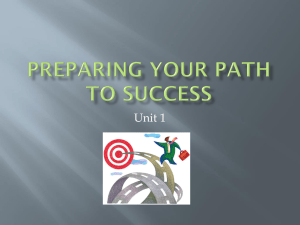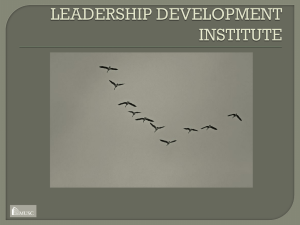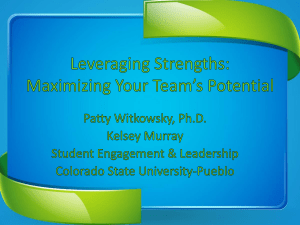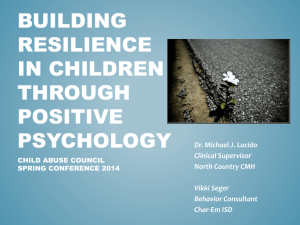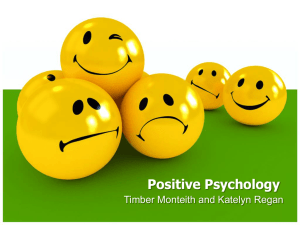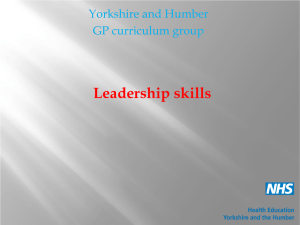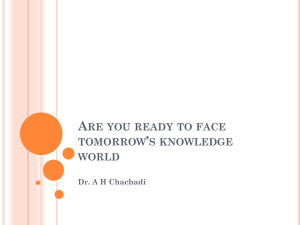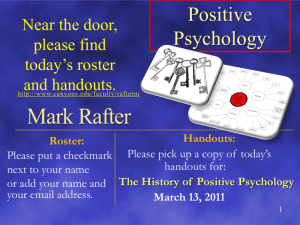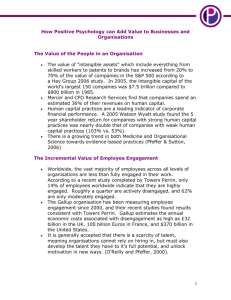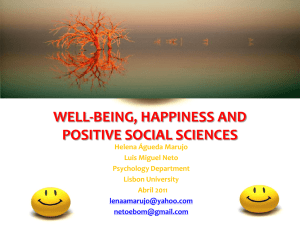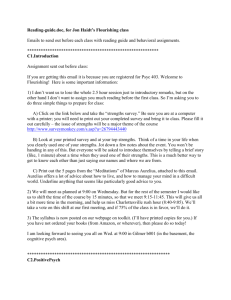Powerpoint - Kansas Association of School Psychologists
advertisement
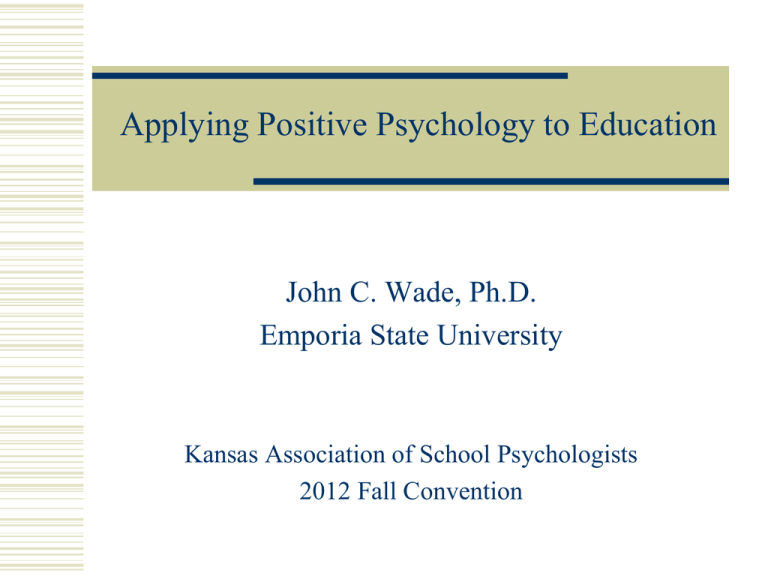
Applying Positive Psychology to Education John C. Wade, Ph.D. Emporia State University Kansas Association of School Psychologists 2012 Fall Convention Overview Fundamentals of Positive Psychology Creating Hope Setting the Stage Working From Strengths Addressing Problems and Framing Solutions Goals Stimulate thinking Approach, not just techniques Foster reflection and intentionality Interactive/exercises Very Brief Introduction to Positive Psychology “Happiness is mostly a by-product of doing what makes us feel fulfilled.” - Benjamin Spock “The most basic assumption that positive psychology urges is that human goodness and excellence are as authentic as disease, disorder and distress.” - Christopher Peterson Positive Psychology Study and science of the factors that lead to successful, meaningful and happy lives. People want not only to move from feeling miserable to feeling OK, but from feeling OK to feeling good (satisfied, productive, etc.) Study of success, achievement, and positive outcomes Happiness Is… According to some ancient Greek traditions, we can’t answer if we are happy until after we die… Happiness = set point + life circumstances + volitional activity (Lyubormirsky, Sheldon, & Schkade, 2005) Or layman’s language: Happiness = Genetics + Circumstances + Actions Well Being When have you experienced well-being? Role of Circumstances Lottery winner/paraplegics (Seligman, 2002) Positive and negative implications of adaptation We are poor predictors (Gilbert, 2006) Actions are only area we have total control over (Seligman, 2002) We don’t habituate to actions like we do our circumstances (Lyubormirsky, Sheldon, & Schkade, 2005). Best Route to Happiness: Intentional Activities Gratitude – counting our blessings. Inhibits social comparisons. Lyubormorski’s (1994) research – gratitude had the strongest correlation with happiness. Examples: Writing down three things each day we are thankful for. The Bottom Line Barbara Frederickson – Positive emotions are not just good because they feel good. Research indicates that when we feel positively we are likely to learn more, be more creative, demonstrate more initiative and be more productive. Negative emotions tend to be of immediate help in urgent situations, positive emotions tend to broaden our repertoire of adaptive behaviors and lead to growth and development over time. Broaden and Build studies (e.g., Fredrickson, 2001; Fredrickson, 2003)… Candy study (Isen, Rosenzweig, & Young, 1991) … Facilitating Hope Hope and Competence Typically, people have hope who have successfully met developmental tasks (Snyder, Rand, & Sigmon, (2005). Lopez et al. (2004) – importance of setting developmentally appropriate goals Learning zone, not comfort or panic zone Bandura – mastery… Hope and Growth Hope = Agency + Pathways (Snyder & Lopez, 2007) Goals Goals direct attention and effort toward goal relevant activities and away from goal irrelevant activities. Locke and Bryan (1969) – car driving (goal) research Goals Have energizing function – higher goals equated with higher effort Persistence Arousal, discovery, and/or use of task relevant knowledge and strategies For new tasks people engage in deliberate planning to develop strategies to help attain goals (Locke & Latham, 2002) Feedback Connect to goals Clear and direct Losado ratio Implementation Intentions Putting goals into practice Implementation Intentions (Gollwitzer, 1999) Engaging the Elephant The elephant and the rider (Haidt, 2006) Hope - springboard for growth, providing energy and momentum to power the work required for change Engineering for early success Punch-cards 5 minute room rescue How to? Discuss an example of when you have helped someone become more hopeful. Discuss an example of when someone else has helped to make you feel more hopeful. Setting the Stage “All systems are perfectly designed to achieve the results they are currently getting.” - Marv Weisbord, organizational consultant “First we shape our structures and then our structures shape us.” - Winston Churchill Enabling Institutions “Institutional level virtues” – characteristics of the organization that contribute to the fulfillment of its members - (Peterson, 2006) Think of good educational settings you have been associated with. What factors made them good? Four Follower Needs Hope Stability Trust Compassion (Lopez, 2011) Identifying & Working with Strengths Strengths Exercise Share a story that illustrates a strength of yours. Partner – reflect back the strength(s) you heard in the story. Studying What Is Right With People Buckingham and Coffman (1999) – Don’t focus on the weaknesses, work with the strengths. Focusing on strengths helps us deal with deficits. Clues to Strengths Flow… Satisfaction Desire to learn more Excellence Identifying Strengths Bill… Questions to ask? Positive Deviance Positive deviance (e.g., Spreitzer & Sonensheim, 2003) Success builds on success. Positive deviance –examples of success and building upon these Success comes from using strengths, not improving deficits Milton Erikson case example Driver’s ed example Academic Role Models William James Role models for students Think of characteristics you admire of a peer or other role model you know - be specific Which of these characteristics do you already demonstrate? How can you amplify these even more? What characteristics would you like to possess more? What is a realistic step to make progress? Role Models Impact of priming Standardized tests scores Athletic ability Celebrity vs. information priming Scared straight Reducing teen pregnancy Pygmalion studies Fostering a Positive Pygmalion Effect Start early Identifying real strengths Helpful to be armed with info before meeting student More specific the better Engineer early success Operate in individual student’s “learning zone” Addressing Weaknesses Use strengths to address weaknesses Remember how you have worked with or overcome problem areas in the past Strengths based approach – report card… Addressing Problems and Framing Solutions “A problem well-stated is a problem half solved.” - Charles F. Kettering “Life is not about waiting for the storms to pass, but learning to dance in the rain.” - Anonymous “An expert is a person who has made all the mistakes that can be made.” - Neils Bohr Exercise Describe a time when you have had a problem or struggled with a situation. If you grew and made positive change, what enabled you to make progress? (Personal factors, situational factors…) If you remained stuck and were unable to make progress, what factors kept you stuck? (Personal factors, situational factors…) Shrink the Problem Engineer to early success to create hope Use scaling. Student reports being at 2 or 3. Supervisor notes being 20-30% of the way there. What would it take to get you to a 3 or 4? “What’s the next action?” Adapted from Heath & Heath (2010) Learning Orientation Positively associated with performance (Button, Matthieu, & Zajac, 1996; Phillips & Gully, 1997) Learning viewed as process Mistakes – opportunities to learn and reevaluate strategies Mindset Training Create the expectation of failure along the way Carol Dweck (e.g., 2006) Growth mindset recognizes effort rather than skill Junior high students – “brain is like a muscle” training “Everything can look like a failure in the middle.” Rosabeth Moss Kanter Harvard professor Failure Convey to students the paradoxically optimistic message – you will struggle, but succeed in the end. NY teacher grades Patina Eastern/Narrative Perspectives Eastern perspective/dialectic What is being left out? Narrative Therapy The person is not the problem, the problem is the problem Envision possible different narratives and future directions Discussion/Questions Contact Info John Wade jwade2@emporia.edu
